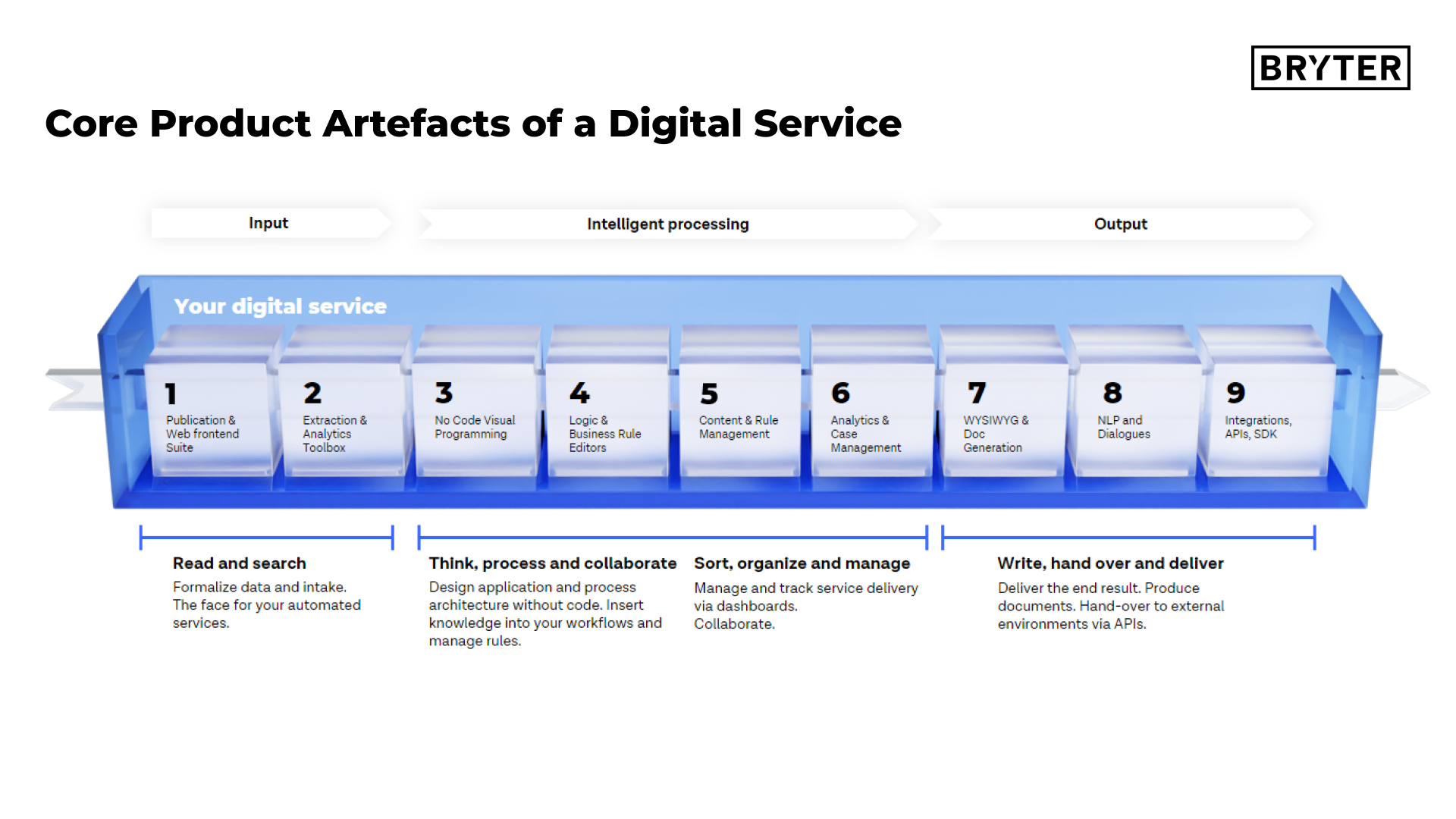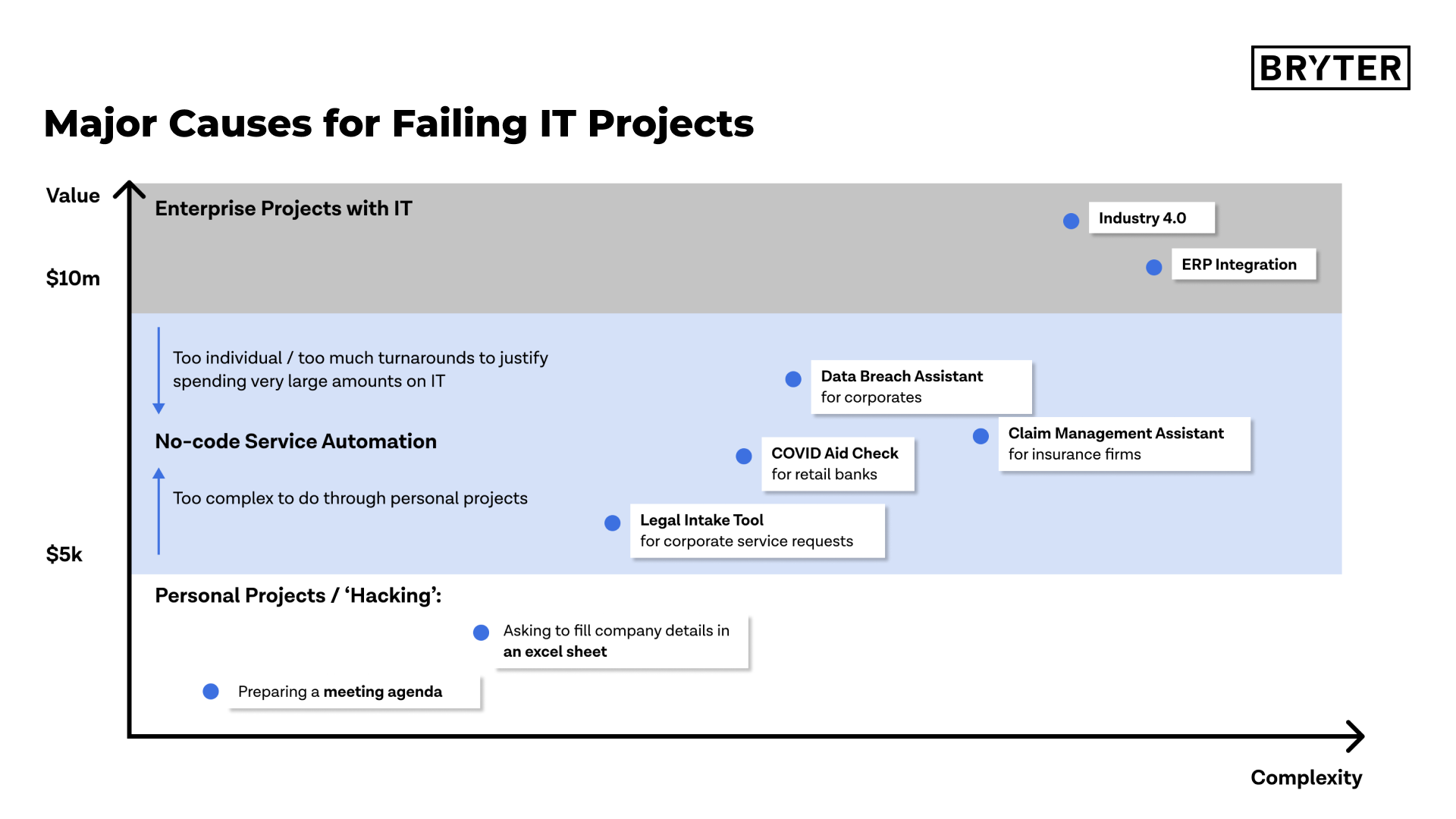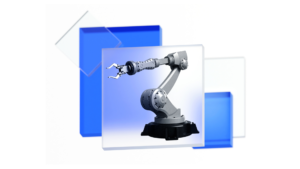- Services consist of 3 simple steps
- Today’s services are often manual and unscalable
- Service automation addresses these concerns
- The product features of a comprehensive service automation platform should represent the different steps of a service
What is a service?
Let’s start with the concept of a service. It’s the delivery of an intangible, knowledge-based asset that provides value to a customer or a colleague.
There are 3 simple steps in service delivery:
- A piece of information is collected whether, from a dialogue, reading, research or even via big data. In today’s digital world, the medium through which this happens is increasingly email, Slack or even via a chatbot.
- The information gets processed, filtered, sorted, modified, … changed – you get it: there is some action happening that often derives from the specific skillset of an expert or ‘knowledge worker’.
- An outcome that aims to provide value. This can be text, a resulting action or simply, an answer. The outcome is shared, and can ideally be stored, managed and analyzed later on (to be reused in step 2!).
Example time!
- You want to accept a gift from your client. You reach out to your compliance officer via mail to ask this question and provide the details of the client and the gift – input!
- The compliance officer applies the company’s gift policy, something she happens to know by heart, learned over the years she’s been at the firm. Then the officer sends the request over to your line manager for approval.
- The advice has been given and the request is approved. You can offer the gift to your client.
As you notice, the same framework of (1) an input, (2) advice or knowledge-based action, and finally (3) an outcome can be applied to every service. Whether you’re a tax consultant assessing the implications of business travel or an employment lawyer advising freelancers. Whether you are a business service provider setting up a new branch for your corporate client, or a People manager onboarding a new joiner that joined your firm. Input, action and output is the rhythm you are operating at.
What are the challenges of service delivery today?
One word: scalability. It’s often hard to do more work without more hands – or as we like to say: more brains. You do both the onerous manual tasks as the complex reasoning, but they are often so connected it’s hard to outsource just that first part to someone else. There are three simple reasons for this:
- Services are mostly individual. Experts assess one specific situation based on the individual information that was provided. This makes the first two steps of the afore-mentioned process the most crucial points: data is individual, the reasoning applied to the individual data varies. This prevents the service from being scaled easily, let alone turned into a software product.
- Services require ‘manual’ input. As the expert is personally involved, service delivery always requires participation. This makes services expensive. Also, the service– once produced – can in most cases not be reused, preventing economics of scale and flattening delivery costs. Consumers of your service have difficulties self-serving, which leads to lower service levels, lack of distribution of knowledge and limitations in the expert’s reach.
- Domain experts don’t have coding skills. This has always made the digitization of services hard, expensive, or impossible. IT involvement means a certain ROI threshold needs to be reached. We’re the first to recognize defending and justifying an IT budget is one of the hardest things to do. Only a few real long-term projects get digitized.
Besides scalability, this has some further drastic consequences. We note the following three:
- Manual service delivery prevents transparency, clarity and controllability. Human service offerings can be error-prone, or flat out incorrect. They are hard to measure, later on, preventing expert teams to have insight into KPIs or analytics on the frequency and relevance of their services.
- Service business models are often reactive, rather than proactive. Teams that deliver services don’t have time to think actively about their offering: lawyers can be struggling to catch up with offerings of digital competitors, and in-house departments don’t get to participate in strategic dialogue because of this.
- Services are less differentiated. Homogenous business models prevent providers to change strategies on the offering. Imagine a team whose offering is so versatile that it can be adapted quickly to markets, audiences and situations! To conclude: services are qualified by a high level of manual, intellectual contribution by a person that provides value to a client or colleague.
Service Automation to the rescue
Services Automation allows to solve these challenges and go beyond the limitations. It tackles the three root causes:
- Turning services into digital offerings allow the service to be productized and scaled easily. It can be used multiple times at no or significantly reduced distribution costs.
- Digital, automated services run independently from the expert’s input. This makes services easily available and significantly improves service level, uptime, and speed.
- It does this without code. Zero. Completely tailored to the business expert.
Maneuver
Turn manual services into digital applications. Accessible everywhere, anytime, at a fraction of the cost.
Enable users to quickly maneuver and capture tipical subject matters.
Monetize
Turn manual services into digital products. Commodities are scalable assets, allowing providers to add revenue, expand the portfolio and turn cost centers into profitable units, servicing clients internally and externally.
Manage
Keep an overview on service offering and content. Share and collaborate. Provide a digital repository for teams and departments without the risk of failing knowledge transfer or creating silos.
Measure
See what services are needed, how they are used and how users consume these service offerings.
Benefit from business process intelligence in an area that was manual and intrasparent before.
And consequently also turns threats into opportunities:
- Digital services can be controlled, measured and analyzed. Both the provision of the service as well as the consumption can be analyzed and a full overview about what is possible
- Turning the analogue service offering into a digitally enhance model allows to leverage advantages of so-called ‘commoditized offerings’, which allows business to plan, grow and scale more easily. These are offerings where teams delivering a service can quickly pick and choose what to offer and to what extent.
- Consultants can try new business models and see what works for them.
In the end, what service automation does, is upskilling the experts to deliver digitally.
Core elements of service automation platforms
What’s in a word. Service automation is designed with services in mind. This means it needs the technical components to represent a service digitally. In short, they correspond to the 3 steps in a service: input, action and output.

The above figure shows the string of actions well. On the left data is collected, in the middle it’s processed and on the right, the output happens. Let’s quickly zoom in on these required features:
- A convenient and standard way to do this is through a web front-end. It allows users to fill in a form, upload information or operate a mobile app. The ‘face’ of your service can take many forms, including a chatbot. Chatbots aren’t standalone solutions. They are just a popular ‘face’.
- An advanced way of information retrieval is through text extraction: literally taking a piece of text, reading and understanding it (at least partially). Your service automation platform can either offer this out-of-the-box or integrate with many of the well-known text extraction providers.
- Everything that happens in the back. Often there is a specific process attached to a service. Do you need specific approval? Check. You want to collaborate or handover the request? Check. A visual workflow editor or visual programming is ideal for this, as business users can do it themselves without needing any code.
- A service automation platform that is tailored to the business side undisputedly needs a rule editor. These are different forms such as decision trees and tables that capture what’s in your head. Essentially, a rule editor is what makes services truly scalable. Again, you shouldn’t need code to implement your rules! Sidenote: this element is what alternative solutions that don’t focus on services, such as RPA or BPM, are often lacking.
- Different ways to manage the rules are crucial, but a great service automation platform can manage various types of content. Content management is needed in some cases to manage specific documents or store inputs in a database, whether through a native database, MySQL or SharePoint.
- The status of your service can then be tracked via case management. After delivery, this is also the product feature that allows further insight, measurement of KPIs and other analytics
- After the service is modified and stored, it is of course delivered. This communication can again take various forms, such as through a document that’s created (doc generation), an email, a Slack message, or any output that’s linked back to the ‘face’ of the service.
- Finally, the service can be extended into various other software via an API. Service automation can offer your IT team to look under the hood for even further customization via any SDK. This means you can code if you want to, but you don’t have to!
The whole feature list can look somewhat overwhelming at first, but as we’ve been saying all along: services are complex animals that need a tailored approach. If you look at any of your services, you’ll quickly see that the process inherently breaks down into these features. We just offered a way to make all of them digital.
Example: you’re asked to adjust a high volume of contracts to reflect the impact of new trade regulations. There’s a request coming in, some text is extracted, and specific rules are applied that change the content of this text. A new document is generated. This can happen up to 95% automatically, leaving you to think of your company’s strategy to think proactively about the strategic implications these contract changes are having.
Or this one: you’re assessing a data breach. The data breach is first investigated. Some more inputs are required. Then an evidence-based decision is made. All assessed inputs are stored in your content management system, as well as the logic that you apply to assess the data breach. The assessment trail can, later on, be audited and improved. Service automation frees you from keeping track of different cases yourself, maintaining and storing documents and allows you to gain insight into what really happened.

Despite these two examples being quite different in nature, they require similar product features, that can be adapted quickly to your use case. They are too complex to do through personal projects, yet are too individual or require too many turnarounds to spending large amounts on IT. And in the end, your service will be digital and scalable, or not be at all.
Service automation is more than just a trend and more than a concept. BRYTER is all about enabling experts to scale their knowledge. But our no-code platform is part of a bigger context, recently taking shape: book a demo to see how BRYTER can transform your business too.








